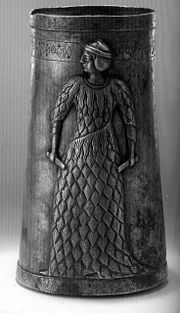
Linear Elamite
Encyclopedia

Bronze Age
The Bronze Age is a period characterized by the use of copper and its alloy bronze as the chief hard materials in the manufacture of some implements and weapons. Chronologically, it stands between the Stone Age and Iron Age...
writing system used in Elam
Elam
Elam was an ancient civilization located in what is now southwest Iran. Elam was centered in the far west and the southwest of modern-day Iran, stretching from the lowlands of Khuzestan and Ilam Province, as well as a small part of southern Iraq...
, known from a few monumental inscriptions only. It was used contemporarily with Elamite Cuneiform
Elamite Cuneiform
Elamite cuneiform was a logo-syllabic script used to write the Elamite Language.- History and Decipherment:The Elamite Language is the now extinct language spoken by Elamites, who inhabited the regions of Khuzistān and Fārs in Southern Iran...
and likely records the Elamite language
Elamite language
Elamite is an extinct language spoken by the ancient Elamites. Elamite was the primary language in present day Iran from 2800–550 BCE. The last written records in Elamite appear about the time of the conquest of the Persian Empire by Alexander the Great....
.
It was in use for a brief period of time during the last quarter of the 3rd millennium BC
3rd millennium BC
The 3rd millennium BC spans the Early to Middle Bronze Age.It represents a period of time in which imperialism, or the desire to conquer, grew to prominence, in the city states of the Middle East, but also throughout Eurasia, with Indo-European expansion to Anatolia, Europe and Central Asia. The...
. It is often claimed that Linear Elamite is a syllabic writing system derived from the older Proto-Elamite
Proto-Elamite
The Proto-Elamite period is the time of ca. 3200 BC to 2700 BC when Susa, the later capital of the Elamites, began to receive influence from the cultures of the Iranian plateau. In archaeological terms this corresponds to the late Banesh period...
writing system, although this hasn't been proven. Linear Elamite has not been deciphered, in spite of several attempts, most notably those of Walther Hinz and Piero Meriggi.
There are only 22 known documents in Linear Elamite; they are identified by letters A-V (Hinz, 1969, pp. 11–44; Andre‚ and Salvini, 1989, pp. 58–61); of these, 19 are on stone and clay objects excavated in the acropolis at Susa
Susa
Susa was an ancient city of the Elamite, Persian and Parthian empires of Iran. It is located in the lower Zagros Mountains about east of the Tigris River, between the Karkheh and Dez Rivers....
(now kept in the Louvre
Louvre
The Musée du Louvre – in English, the Louvre Museum or simply the Louvre – is one of the world's largest museums, the most visited art museum in the world and a historic monument. A central landmark of Paris, it is located on the Right Bank of the Seine in the 1st arrondissement...
in Paris).
The most important longer texts, partly bilingual
Bilingual inscription
In epigraphy, a bilingual is an inscription that is extant in two languages . Bilinguals are important for the decipherment of ancient writing systems.Important bilinguals include:...
, appear in monumental contexts. They are engraved on large stone sculptures, including a statue of the goddess Narunte (I), the "table au lion" (A), and large votive boulders (B, D), as well as on a series of steps (F, G, H, U) from a monumental stone stairway, where they alternated with steps bearing texts with Akkadian titles of Puzur-Inšušinak. A unique find is item Q, a silver vase with a single line of perfectly executed text, kept in the Tehran Museum. There are also a few texts on baked-clay cones (J, K, L), a clay disk (M), and clay tablets (N, O, R). Some objects (A, I, C) include both Linear Elamite and Akkadian cuneiform inscriptions. The bilingual and bigraphic inscriptions of the monumental stairway as a whole, and the votive boulder B have inspired the first attempts at decipherment of Linear Elamite (Bork, 1905, 1924; Frank, 1912).
External links
- http://cdli.ucla.edu/wiki/doku.php/linear-elamite
- http://www.ancientscripts.com/elamite.html

